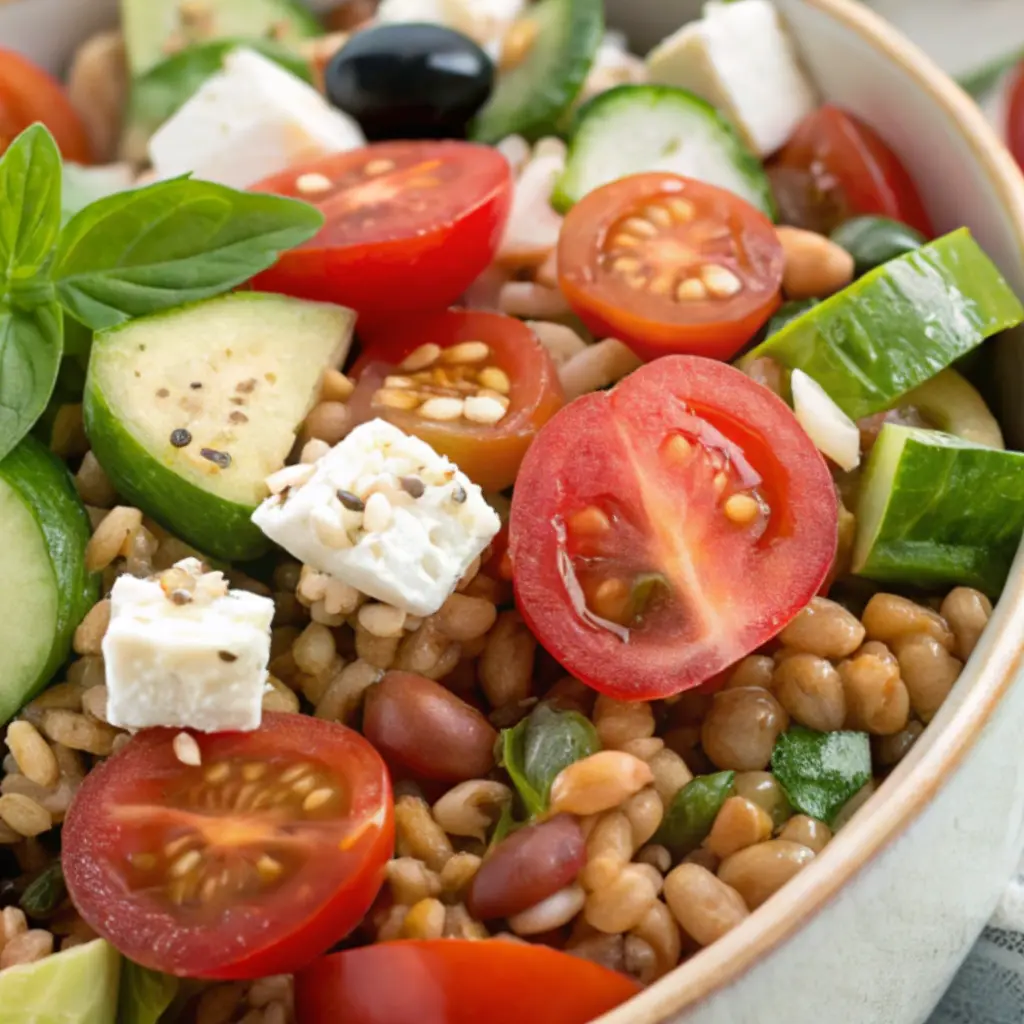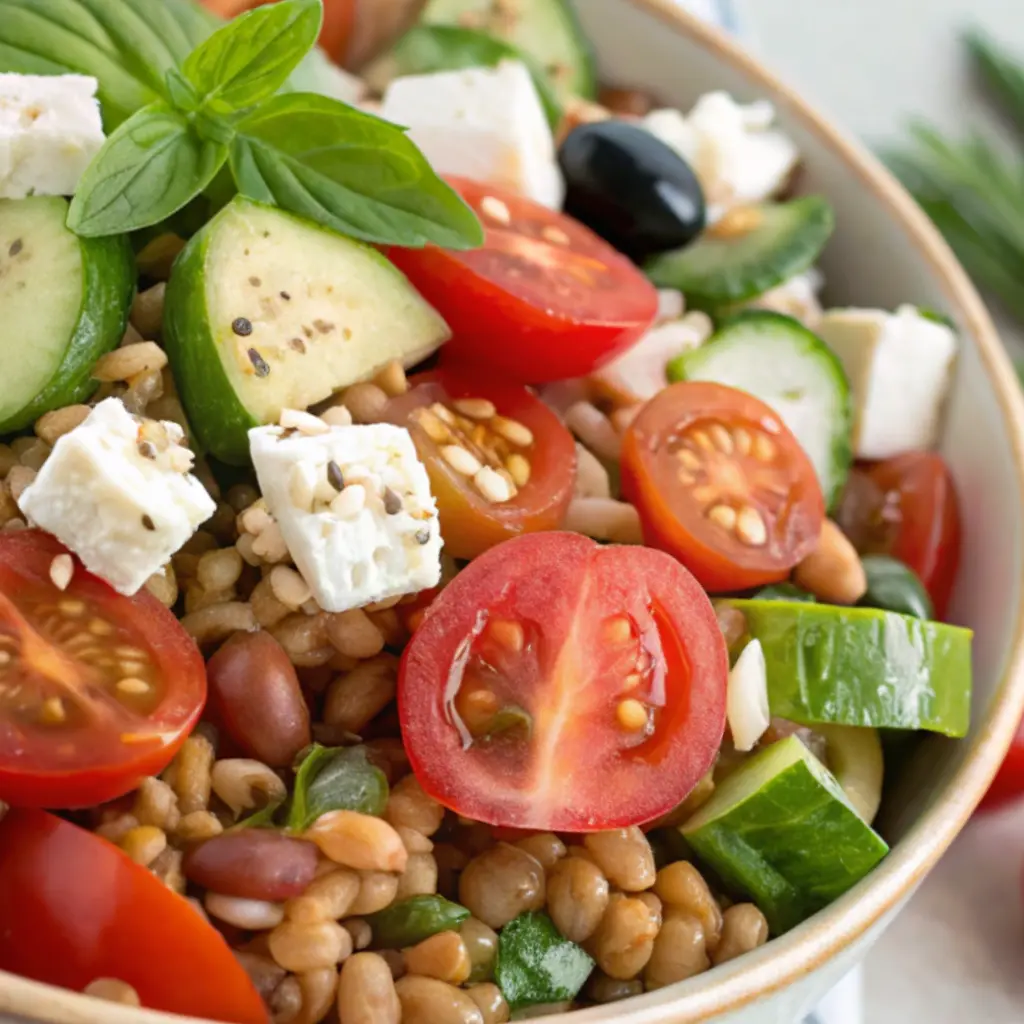I first made this farro salad on one of those summer afternoons that stretch out like lazy cats in the sun—too warm to cook anything complicated, but too lovely not to gather people around the table. I remember it vividly because I’d just returned from the Saturday farmer’s market with a canvas tote full of too many vegetables (a habit I’ve never managed to kick), and a small bag of farro I bought on a whim, mostly because the woman selling it said her grandmother swore by it. I didn’t grow up with farro, but something about its nutty smell and the way it plumped up in boiling water reminded me of the barley my mother used to put in soups. That first version of the salad wasn’t perfect—I overcooked the farro and added too much lemon—but everyone still asked for seconds, and that’s always a good sign. Since then, it’s become a staple in my kitchen: endlessly flexible, hearty but fresh, and just as good the next day, which, frankly, is when I like it best.

Why You’ll Love This Recipe:
- Hearty and satisfying, yet light and refreshing
- Packed with texture and vibrant flavor
- Great for meal prep and make-ahead lunches
- Flexible enough to accommodate whatever veggies or herbs you have on hand
- A crowd-pleaser at potlucks, picnics, and summer dinners
Ingredients You’ll Need:
Farro (1 cup, uncooked) – I use pearled farro because it cooks faster, usually in about 20-25 minutes. You can use semi-pearled or whole, but be aware the cook time will increase significantly. Rinse it well before cooking, just like you would rice.
Cherry tomatoes (1½ cups, halved) – Sweet and juicy, these bring a burst of freshness. In the winter, I sometimes roast grape tomatoes to coax out more flavor.
Cucumber (1 medium, diced) – I usually go with English cucumbers because they’re seedless and not watery, but any crisp variety works.
Red onion (¼ cup, finely chopped) – A little goes a long way. I soak the chopped onion in cold water for 10 minutes to take the edge off.
Feta cheese (½ cup, crumbled) – Adds creaminess and a salty bite. If you’re dairy-free, a sprinkle of chopped olives gives a similar tang.
Fresh herbs (½ cup total, chopped) – I like a mix of parsley and mint. Dill or basil also work beautifully, depending on the season and mood.
Lemon juice (from 1 large lemon) – Freshly squeezed makes all the difference. I’ve tried bottled juice in a pinch, and it’s never quite the same.
Olive oil (¼ cup) – Use a good one here; it’s the base of the dressing. It doesn’t have to be fancy, but it should taste like something you’d happily dip bread into.
Salt and freshly ground pepper (to taste) – I start with ½ teaspoon of kosher salt and adjust once everything is mixed. Farro needs seasoning to shine.
How to Make It (Step-by-Step Instructions):
Start by cooking the farro. Bring a medium pot of salted water to a boil, then add your rinsed farro. Think of it like pasta—you’re going to boil it until tender, then drain. I taste a few grains at the 20-minute mark. You’re looking for something pleasantly chewy, not mushy. Once it’s cooked, drain it well and spread it out on a baking sheet or large plate to cool faster. I like to drizzle just a touch of olive oil over it at this stage to keep it from clumping and to add a little flavor while it’s warm.
While the farro cools, prep your vegetables. Halve the cherry tomatoes, dice the cucumber, chop the herbs, and crumble the feta. If you haven’t already, go ahead and soak your onions in cold water—this really softens their bite without losing their character.
Now the dressing. In a small bowl, whisk together the lemon juice, olive oil, and a pinch of salt and pepper. Taste it. If it makes your mouth water, it’s perfect. I sometimes add a tiny dab of honey if the lemon is particularly sharp, but usually, the tomatoes and onions balance things out.
In a large mixing bowl, combine the cooled farro with the vegetables, herbs, and feta. Pour over the dressing and toss gently, making sure everything gets coated. Let it sit for at least 10 minutes before serving—longer if you have time. This resting period helps the flavors meld, and the farro absorbs just enough of the dressing to become deeply flavorful.

Expert Tips for the Best Results:
One of the best things I’ve learned about farro is that it’s happiest when it’s generously seasoned and paired with juicy ingredients—it soaks up flavor like a sponge. Always taste your farro while it’s cooking; it’s easy to overcook if you’re distracted (ask me how I know). And don’t skip the cooling step—mixing hot farro with fresh veggies will make the herbs wilt and the cucumbers go soft. Give it a little breathing room and you’ll be rewarded with a salad that holds up for days.
Variations & Substitutions:
This salad is a true chameleon. I’ve swapped the feta for goat cheese, the cucumbers for zucchini ribbons, and once even threw in grilled peaches and arugula when I was short on tomatoes. One evening, I realized I was out of fresh herbs and used a spoonful of pesto instead—it turned out so flavorful I’ve done it that way several times since. Cooked chickpeas, chopped kale, or roasted sweet potatoes can turn it into a main dish. Really, once you get the farro base down, the possibilities are endless.
Serving Suggestions:
I love serving this farro salad alongside grilled chicken or fish, especially when we’re eating outside in the early evening. It’s also a wonderful addition to a mezze-style table—think hummus, warm pita, olives, and something cold and crisp like this. For lunch, I scoop a big portion into a bowl, maybe add a soft-boiled egg on top if I’m extra hungry, and call it a day. It’s casual, unfussy food that still feels special.
Storage & Reheating Instructions:
I keep leftovers in an airtight container in the fridge for up to four days. The flavors deepen over time, and the farro stays pleasantly chewy. If it dries out a bit, a splash of lemon juice or olive oil perks it right back up. I don’t usually reheat it—it’s best served cold or at room temperature—but if you do, a gentle warm-up in the microwave for 30 seconds is all it needs. Just be mindful not to overdo it, or the cheese and herbs can get a little sad.
Recipe FAQs (Answered by Clara):
Can I make this ahead of time?
You sure can. I often prepare it in the morning, cover it tightly, and pop it in the fridge. It actually tastes better after resting.
Is farro gluten-free?
No, farro is a type of wheat, so it’s not gluten-free. If you need a gluten-free version, try quinoa or brown rice—both work well in this salad.
Can I use dried herbs instead of fresh?
You can, but fresh really makes a difference here. If dried is all you have, use them sparingly and add a little extra lemon to brighten things up.
How can I make this a full meal?
Add a protein like grilled chicken, canned tuna, or roasted chickpeas. Sometimes I even toss in leftover salmon—it’s very forgiving

There’s something deeply comforting about a recipe that welcomes improvisation, doesn’t mind being made ahead, and still manages to taste like a treat. This farro salad is that kind of recipe. I hope it finds a place in your kitchen the way it has in mine—reliable, nourishing, and full of little surprises depending on what you have on hand. If you try it, let me know how it turned out, or better yet, tell me what you changed. Recipes live and breathe in community, and I’d love to hear your version.
Nutrition Information (Approximate, per serving):
Calories: 280
Protein: 7g
Carbohydrates: 32g
Fat: 14g
Fiber: 5g
Sugar: 3g
Sodium: 320mg


Leave a Reply